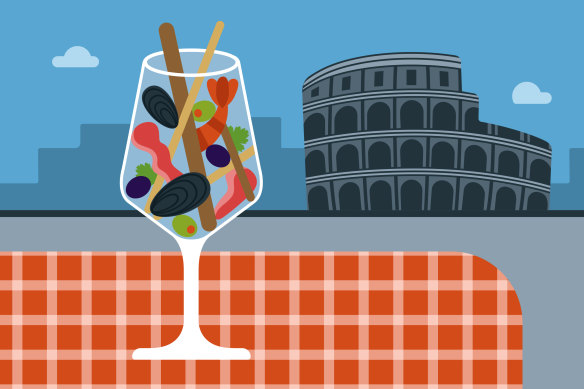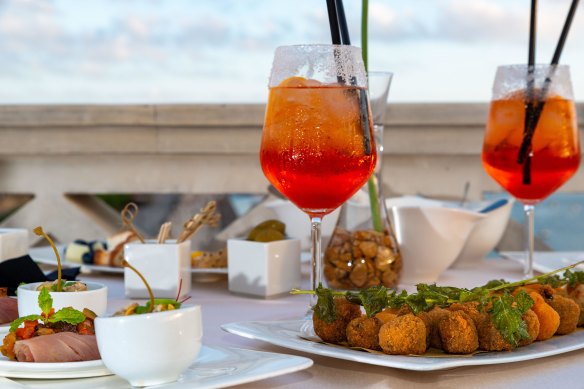How to eat (almost) for free when in Italy
Did you know that Italians don’t snack? It’s a fascinating fact, considering their lunch is around 1pm, and dinner isn’t until 8pm. Instead, they indulge in a pre-dinner ritual known as aperitivo, a golden opportunity for travellers to savour the flavours of Italy without spending a euro (almost).

Non-snacking Italians offer food for thought.Credit: Illustration: Greg Straight
Think of aperitivo as the refined older sibling of happy hour. At dusk, Italy’s charming streets are packed with locals unwinding in bars, sipping spritzers (Aperol spritz) or wines and picking at platters overflowing with fresh cheeses, cured meats and olives.
Non-alcoholic options like Cordino are available, but the focus is on lighter pre-dinner drinks. So skip the grappa, limoncello, nocino, and amaro – they’re for after your meal. Aperitivo is all about whetting your appetite.
The aperitivo ritual began in the 1700s, coinciding with the invention of the sweet wine-based drink vermouth. Meaning “to open” in Italian, aperitivo was originally intended to stimulate the tastebuds before dinner. However, it has blossomed into a social tradition deeply cherished throughout Italy.
Aperitivo can be a bit tricky to navigate for newcomers. It varies not only by city but also from one establishment to another.

Aperitivo is a deeply cherished tradition in Italy.Credit: Alamy
There are three main approaches you might encounter. The most generous is the all-inclusive aperitivo, where your drink purchase unlocks a complimentary spread of delicious bites. It’s a fantastic deal, but remember the idea is to keep the drinks flowing alongside the continuous stream of snacks.
In Lecce, nicknamed the Florence of the South, Bamboo Bar is a local spot, where a €7 spritz gets you a table overflowing with food, like focaccia, olives, panzerotti, sandwiches, calzone, and more.
The a la carte aperitivo offers more control. You pay separately for your drinks and any food you choose from the menu, which often includes a platter of local delicacies. For instance, in Puglia, focaccia, olives, and crusty bread knots are common bar snacks.
While buffet-style aperitivo isn’t as common, a little research can unlock hidden gems in your chosen city. In Florence, Caffe Sant’Ambrogio is known for its legendary buffet aperitivo.
So how does one experience aperitivo? Between 6-9pm, head to a lively bar or cafe – those with a buzz or “aperitivo specials” signs are your best bet, but just about any establishment serving food and drinks will do. Order your drink and mention “aperitivo” to ensure you get complimentary snacks with your beverage.
The best city for it is Milan, considered the birthplace of the aperitivo. Visit the lively scene in Navigli and Brera neighbourhoods.
In Rome, Trastevere is famous for an aperitivo scene that extends well into the night. And in Florence, the mix of young professionals and university students makes it a prime audience for the tradition.
Relax, sip slowly, savour the conversation and snacks, and soak up the atmosphere – that’s the essence of aperitivo.
Sign up for the Traveller newsletter
The latest travel news, tips and inspiration delivered to your inbox. Sign up now.